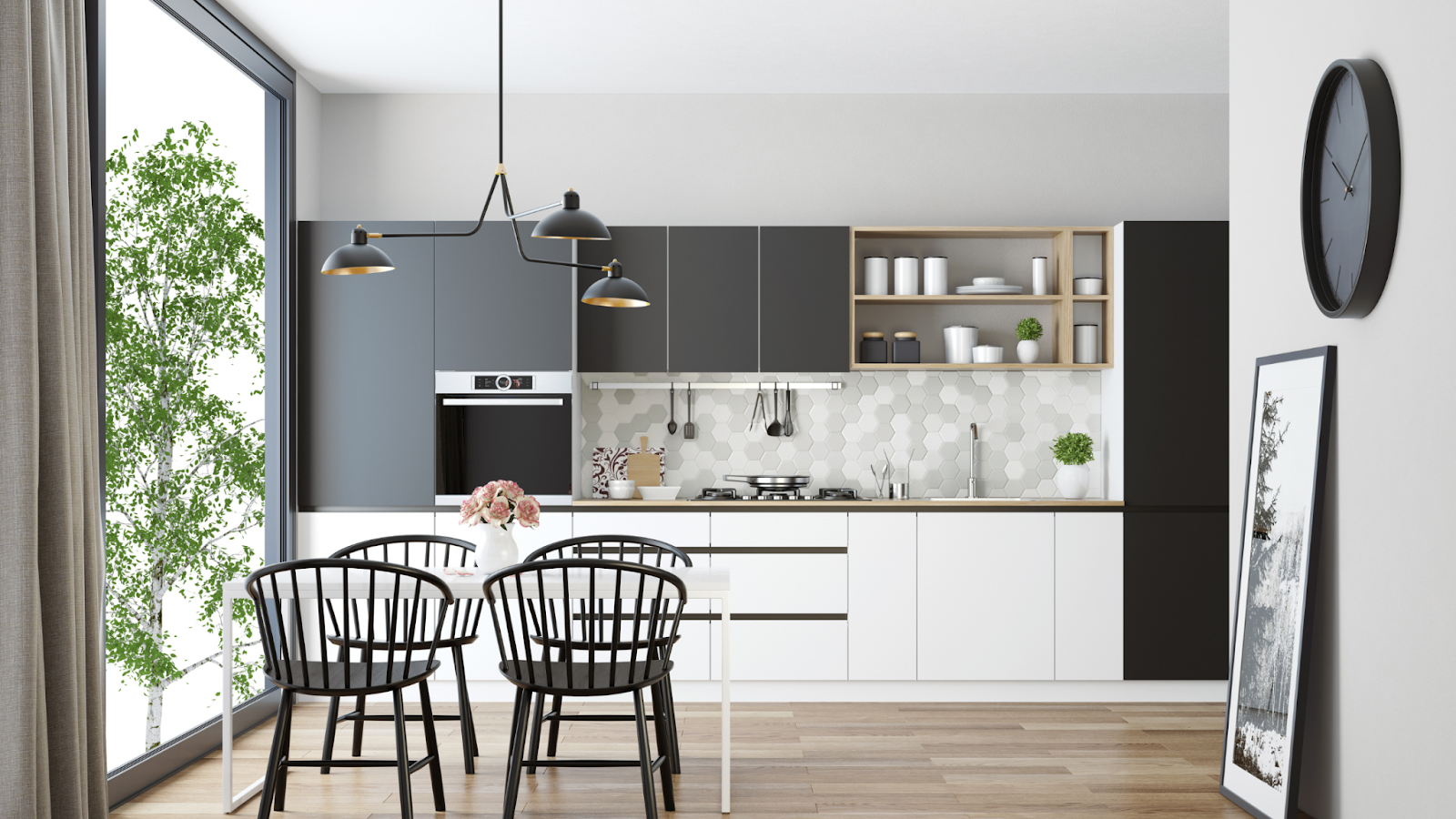Welcome to the future of living in Toronto! We’re here to give you ideas and tips on how to design your home in order to future-proof it. And we will use the city of Toronto as an example. But the general ideas are similar or the same worldwide.
In this dynamic city, where modernity and innovation thrive, stay ahead of the curve when it comes to designing and upgrading your home. The Toronto real estate market is manipulated by buyers who crave the futuristic charm that cutting-edge technology and contemporary aesthetics offer.
Understanding the modern home features that can make or break your chances of a successful sale is vital as a seller. We’re here to guide you through the exciting world of home design and showcase the key trends that will elevate your Toronto home to new heights.
Table of Contents:

Smart Home Tech: The Future Is Here!
When it comes to modern Toronto homes, there’s no denying the appeal of cutting-edge technology. Whether you’re a fan of contemporary aesthetics or prefer a more vintage look, one thing is for sure: modern amenities can elevate your living experience to a whole new level.
In this fast-paced world, buyers are on the lookout for homes that exude a futuristic charm.
Homebuyers want features and traits that scream “future” So, if you’re a seller, it’s crucial to understand which modern home features can make or break your chances of a successful sale. Before diving into any home improvement decisions, though, it’s always wise to consult with the experts to ensure the long-term value of your investment.
Now, let’s talk about one of the hottest trends in modern homes: smart home technology. Picture this: you arrive home after a long day, and before you even step through the door, your voice-activated virtual assistant informs you about the weather outside. In Toronto, we adore our smart home tech, but setting it up can be a hassle. That’s why having a home that’s already wired to effortlessly embrace smart home technology is a massive advantage for buyers.
| Did you know? The smart home is a growing subject of research and development due to its potential to improve daily living, reduce household energy use, and be the next wave of electrification and digitalization. |

Seamless Integration and Convenience
Buyers crave easy integration, lightning-fast internet, and user-friendly interfaces that make utilizing smart home tech a breeze. But it’s not just about convenience or turning ounces into millilitres for that perfect cocktail recipe. Smart home technology offers so much more—it’s about accessibility, safety, and transforming the way we live.
In today’s world, smart home tech can do wonders. Imagine having music playing in every room, lights that turn on automatically, or even knowing who’s at your door before you answer it. With security cameras, you can keep a close eye on your property even when you’re away. Forgot to turn off the oven? No worries—your smart home system has got you covered. It can even maintain the ideal temperature throughout the day. These automated features alleviate the stress of daily tasks and can truly make a difference in a buyer’s life.
Lighting the Way: Energy Efficiency and Sustainability
One important aspect of modern homes is energy efficiency. In an era where sustainability is at the forefront of our minds, buyers are actively seeking properties that align with their eco-friendly values. Toronto is a city that cares about the environment, and having energy-efficient features can make your home all the more appealing. Investing in LED lighting, smart thermostats, and energy-efficient appliances not only reduces your carbon footprint but also saves you money in the long run.
These features demonstrate your commitment to sustainability and can be a major selling point for environmentally conscious buyers.
Engineered Hardwood: The Luxurious and Sustainable Flooring Option
In the world of home design, laminate flooring has had its fair share of skeptics. While it offers durability, affordability, easy installation, and an attractive appearance in most cases, many people still associate the term “laminate” with cheapness. However, there’s a new player in town that has been gaining popularity among modern homeowners: engineered hardwood. So, what exactly is engineered hardwood?
Think of it as the “gold-plated” jewelry of the flooring world. It consists of thin layers of hardwood attached to plywood, combining the best of both laminate and hardwood.
There’s no denying the timeless appeal of a luxurious hardwood floor. However, for the modern Toronto homebuyer, engineered hardwood is the next best thing.
It offers the same aesthetic appeal and feel as traditional hardwood while providing the advantages of laminate flooring. But that’s not all—engineered hardwood also boasts sustainability credentials, using significantly less wood per plank during its construction.
If you’re thinking about replacing outdated flooring in your home before putting it on the market, consider engineered hardwood. Not only will it appeal to the modern buyer, but it also aligns with the growing trend towards sustainable living.
| Did you know? The engineered wood market was worth $284,761.1 million in 2019, and it is predicted to grow to $400,450.9 million by 2027. |

3 Tips for Creating an Energy-Efficient Home
In today’s world, “high-efficiency” appliances have become commonplace. You’ll find that “HE” symbol on everything from washing machines to dishwashers and refrigerators. However, a truly energy-efficient home goes beyond just these appliances. While some energy-saving measures may be challenging or expensive to implement when selling, here are a few tips to help you make your home Energy Star® compliant.
1. Boosting Insulation: Going the Extra Mile
Building codes specify a certain amount of insulation for homes, but exceeding those requirements can be beneficial. Adding a little extra insulation can help keep your home warmer in the winter and cooler in the summer. Moreover, if your existing insulation is old, outdated, or contains hazardous materials like asbestos, it’s crucial to replace it for safety reasons.
2. Moisture and Vapor Barriers: Preserving Your Home
Moisture and vapour barriers play a vital role in keeping your home dry, protecting its building materials, and preventing issues like rot and mould. While these barriers are commonly used in high-moisture areas such as mudrooms, basements, bathrooms, and laundry rooms, you may consider adding extra moisture protection in other areas of your home, depending on its specific needs.
3. Think Beyond Appliances: The Bigger Picture
While Energy Star® ratings for everyday appliances are important, don’t forget about the larger systems in your home. Traditional water heaters and furnaces, for example, typically need replacement every 15-20 years. Investing in newer, more innovative options such as tankless water heaters and heat pumps can be extremely appealing to potential buyers. With the rise of electric cars, having an electric car charging station in the garage is also a practical and forward-thinking addition.
Discuss Upgrades with Your Agent
Before making significant changes to your home with the intention of selling, it’s essential to have a conversation with your real estate agent. It’s all about strategizing and maximizing your return on investment (ROI). Not every upgrade will be worth it in the end, so it’s crucial to weigh the costs and potential benefits before proceeding.
Heated Floors: The Practical Luxury
Imagine stepping out of a steaming hot shower on a cold winter night, only to have your feet meet the icy chill of the bathroom tile. Talk about ruining the relaxation! But now, picture the same scenario with warm tile underfoot. Ah, pure bliss! Heated floors may seem like a fancy indulgence, but they offer practical benefits beyond luxury.
Radiant heating is not only highly efficient and eco-friendly but also helps reduce dust in the home, making it an excellent choice for those with allergies. Beyond the interiors, heated floors are finding new applications outdoors as well.
Just think about never having to shovel your walkway or driveway again. Heated walkways and driveways are gaining popularity, especially in Canada, where snow is a constant companion. Say goodbye to back-breaking snow removal!
| Did you know? The most common rooms for this form of heating are the bathroom, kitchen, and living room, where people spend the most time. |
Scandinavian-Inspired Kitchens: The Perfect Blend of Simplicity and Functionality
When we talk about “Scandi” style kitchens, we’re not just referring to the popular Swedish furniture store. We’re diving into the concept of hygge—the Scandinavian way of life that embraces simplicity, coziness, functionality, and warmth.
Hygge is all about slowing down from the rapid pace of everyday life to spend time with loved ones or with yourself. The current trend in kitchens leans toward sleek designs with minimalist cabinetry, neutral tones, high-quality appliances, ample lighting, and built-in functionality.
| Did you know? The term hygge, at least in its current sense, goes way back to around 1800. But different meanings of hygge can be found in the Middle Ages when another Old Norse word meant “protected from the outside world.” |

Incorporating Scandinavian-Inspired Design
If you’re looking to bring this sleek and minimalist Scandinavian-inspired style into your home, consider these design tips:
- Soft-Close Cabinetry: Opt for cabinets and drawers with a minimalist design and unfussy handles or knobs. Soft-close mechanisms add a touch of luxury and convenience.
- Light and Sleek Countertops: Granite is no longer the only choice. Explore options like butcher’s block bamboo, stainless steel, marble, concrete, or slate for a light and modern countertop style.
- Neutral Tile Backsplashes: Embrace the timeless elegance of white subway tiles, or explore the endless array of options available for creating a light and neutral backsplash.
- Stainless Steel Appliances: Stainless steel has become the gold standard for highly functional and beautiful kitchens. It complements various design aesthetics, from upscale estates to modern Toronto condos.
- By incorporating these elements into your kitchen design, you can achieve a sleek and functional space that embodies the essence of Scandinavian style.

FAQ
How much do interior designers charge in Toronto?
The cost of hiring an interior designer in Toronto can vary greatly depending on the scope of the project and the designer’s experience. It’s best to contact individual design firms for specific pricing information.
How much does it cost to do interior design in Canada?
The cost of interior design in Canada can vary widely depending on the project’s size, complexity, and the designer’s experience and reputation. It can range from a few hundred dollars for a simple consultation to several thousand for a full-scale project.
How do I become a home designer in Canada?
To become a home designer in Canada, you typically need to earn a degree or diploma in interior design or a related field. You may also need to pass a certification exam and gain professional experience.
What does an interior designer do?
An interior designer helps to create functional and aesthetically pleasing indoor spaces. They work with clients to understand their needs and preferences, create design plans, select materials and furnishings, and oversee the implementation of the design.
What is the role of an architect in designing a home?
An architect designs a home’s structure and layout with an eye toward light, flow, and function. They work closely with interior designers and other professionals to ensure that the home meets the client’s needs and preferences.
What are some top design ideas for homes in Toronto?
Top design ideas for homes in Toronto can vary greatly depending on current trends and individual preferences. Some popular trends include open-concept layouts, sustainable design elements, and incorporating natural materials.

Design Your Home – Final Words
As you consider upgrades and renovations for your home, think about the benefits and appeal they can bring, whether it’s the luxurious look of engineered hardwood, the energy efficiency of the insulation and updated appliances, the comfort and convenience of heated floors, or the simplicity and functionality of Scandinavian-inspired kitchens.
Each of these elements adds value and enhances the overall appeal of your home.













